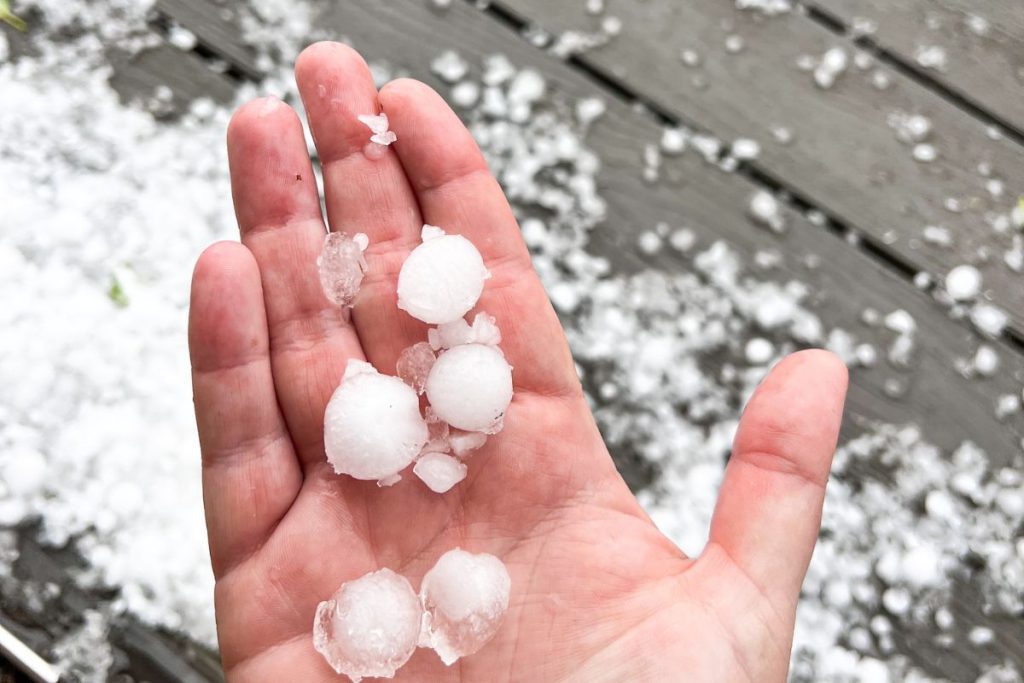
Does Home Insurance Cover Hail Damage?

It’s never fun to see the possibility of hail on the radar. It typically precedes an extreme weather event and, depending on the size of the hail, can cause significant damage.
When it hails, most people think about the damage to their cars, but you should also think about your roof. Hail can reduce the lifespan of your roof and even necessitate a total roof replacement.
If you have hail damage to your roof, the question is whether your insurance company will pay to repair it. We understand that hail damage (or any other type of roof damage caused by extreme weather) can be stressful.
To reduce your stress, we’ll explain whether your insurance company will cover hail damage.
Yes, hail damage and other roof damage caused by extreme weather should be covered by your homeowner’s insurance (strong winds, tornados, fallen limbs, etc.). If you believe your roof has been damaged by hail, you must first contact your insurance company, followed by a roofing contractor.
What is Hail Damage?
Depending on the type of roof you have, hail damage to your roof can take several different forms.
- Asphalt shingle or composite shingle: Round, dark impact marks with few granules may appear. The damaged shingles may feel soft and exposed felt may be visible.
- Wood shingles may have dents and splits, with visible brown or orange spots inside the splits.
- Roof panels, gutters, and vents made of metal may have dents.
How Does Homeowners Insurance Cover Hail Damage?
Typically, the dwelling coverage on your homeowner’s insurance will help cover the costs of repairing or replacing hail-damaged parts of your home. Before your coverage begins, you must still pay your deductible, so keep that in mind before filing a claim. If the cost of repairing the damage is less than your deductible, you should not file a claim.
While your standard homeowner’s insurance policy will cover many of the costs of repairing hail damage, you may want to consider adding a few other types of additional coverages to round out your protection.
- Matching siding coverage
While hail damage to your siding is typically covered by homeowners’ insurance, it only encompasses the damaged siding, which means you may end up with mismatched replacement siding when doing repairs. If the new siding does not match the existing siding on your home, or if a reasonable match cannot be found, corresponding siding coverage will replace the remaining siding on your home up to your coverage limit.
- Coverage of other structures
Your standard homeowner’s insurance policy ought to cover hail damage to detached structures such as a shed or fence. Larger structures, such as sheds larger than 300 square feet, swimming pools, and so on, will need to be scheduled alongside other structures. Your insurance policy may cover hail damage to these structures.
- Coverage for roof replacement costs
Your homeowner’s policy typically covers the cost to repair hail damage done to your roof, but only at its actual cash value (ACV) (ACV). The ACV of your roof is what it is worth today, after depreciation for factors such as age, condition, and material type. Your company, on the other hand, will pay its replacement cost value (RCV), which is what it costs to replace today — not what it’s worth. As a result, you’ll have more coverage to pay for a new roof.
When Is Hail Damaged Not Covered?
While a roof may appear to be hail damaged, another factor, particularly neglect, may be to blame. Sunlight and harsh weather can cause shingles to become brittle and appear damaged. As the shingles age, they may begin to blister, crack, or show signs of granule loss. These types of damages are considered normal wear and tear and are typically not covered by insurance.
Checklist for Filing a Hail Damage Claim
- Take pictures of your home before and after the damage occurs to document it.
- Report significant damage to your insurance company: File the claim as soon as possible to ensure that it is made within your policy deadline.
- Get a free inspection: Consult with a reputable roofing contractor for unbiased advice on the extent of the damage.
- Get an estimate and Negotiate: Ensure that your independent inspection and insurance company’s points of view are in sync.
- Maintain a record of the claim. After filing a claim, you must remain involved until the claim is paid and your home is restored. Keep in touch with the insurance adjuster and the contractor on a regular basis. Take careful notes whenever you speak with an insurance representative. If you have any questions about the process, contact the insurance company.
- Repair the damage: Once the insurer has approved the claim, contact a roofing contractor to repair the damage. Your deductible will be deducted from your total payout.
Hail damage is unpredictable and costly to repair. As a result, you should ensure that your insurance provider not only provides adequate coverage but also has a good track record of handling claims. If you are concerned about a premium increase as a result of filing a hail damage claim, you may be able to find cheaper home coverage elsewhere.
With Klinger Insurance Group, looking for a new carrier is as simple, answering a few quick questions. Compare insurance quotes and coverage options apples to apples to find the policy that is right for you.
Connect with Klinger Insurance Group insurance advisor to review your policy and ensure you’re storm ready. Call today at 301-428-4935 or email us at info@klingerinsurancegroup.com.

Request Your Proposal Here
Are you ready to save time, aggravation, and money? The team at Klinger Insurance Group is here and ready to make the process as painless as possible. We look forward to meeting you!
